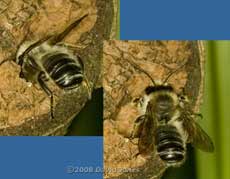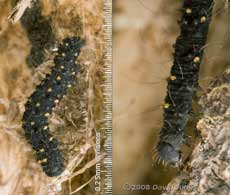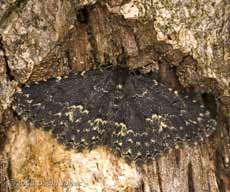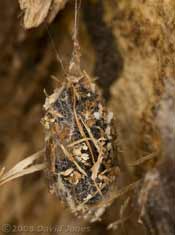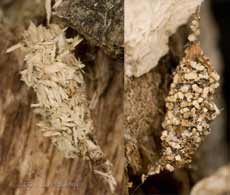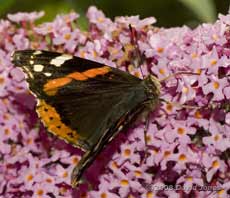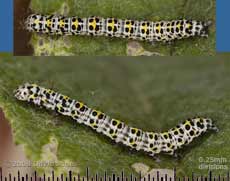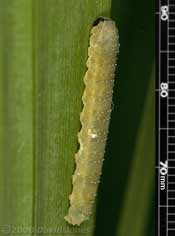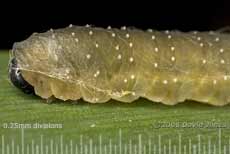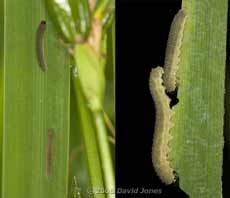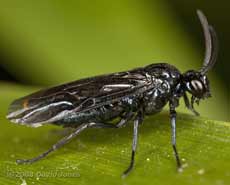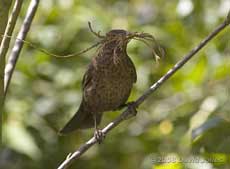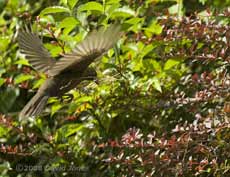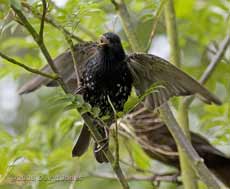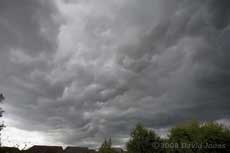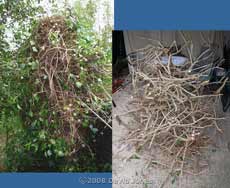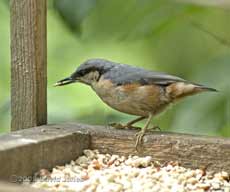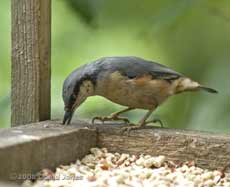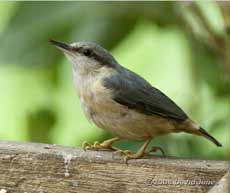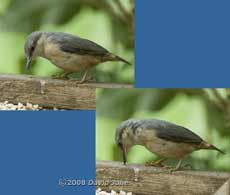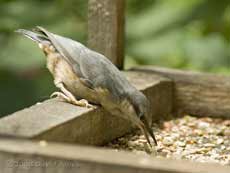Go to the last entry on this page .....Go to previous entry3 July - A mixed start to the month, both for me and the weather. While I'm still trying to get going, July started off with a very warm day with a high of 28C. Since then, the temperature has dropped back down, giving highs of just 19C during a cloudy yesterday and 21C today, although this afternoon we had a few showers and thunder. Yesterday evening I spent a couple of hours outside the front of the house hoping to get a photograph of a Swift entering my neighbour's loft. I failed in that quest but saw up to 18 Swifts overhead. Interestingly, I also saw a House Martin, the first since we came home from our holiday. Also, a quite large flock of Starlings flew over. There must have been at least a hundred of them, the first large group I've seen over us for a long time. The Blackbirds continue to feed their fledglings (definitely at least two) at the bottom of the garden. Since I photographed it I haven't seen the young Greenfinch, but fist thing this morning there were two adults in the garden. Conversely, while the two Robin youngsters can be seen just about all the time, there is still no sign of an adult in the garden. It's fascinating to see how quickly the solitary bees react to the changing weather conditions. After the bee hotels were busy places on the 1st, yesterday's cloud meant that the bees remained in the holes more or less all day. Today they were active again, but as soon as the shower clouds covered the sun the bee hotels would quickly fall quiet again.
Also today I spotted leaf-cutter bee activity for the first time this year, not at the bee hotels but on the cherry tree stump at the middle of the big pond. The stump is at an advanced state of decay, and I could see three places where the bees are excavating.
Back on 29 June I reported seeing four caterpillars on one of the bee hotels. Today I could see just one, measuring about 17mm and definitely feeding, either on the decaying wood itself of perhaps mildew, algae etc growing on the wood.
On the same log was this moth. Probably coincidence, but like the caterpillar it is almost black and with pale markings. With its wings in the arrangement shown here it measures 25mm across. It also has light coloured bands on its legs and slender, narrow banded antennae. As with the caterpillar, I'm at a loss as to its identity. I've gone through my moth guides with no success so far - is it a female of one of the Carpets? - subsequently identified as Waved Black (Parascotia fuliginaria) - see entry for 6 July.
4 July - A pleasant, mainly sunny day with a high about the same as yesterday - 21C. I took advantage of a good day before promised rain on the weekend to do a bit of clearing by the side of the big pond, where some (I think it is) Couch grass had taken over. As usual, these jobs take a long time as I check for insects etc! It was lucky that I did as I disturbed two newts which I moved to a safer spot. As it happened I didn't find any insects.
When I checked on the caterpillar that I photographed yesterday I found instead a cocoon, suspended by a silk thread with what I assume is the caterpillar moving inside it. Perhaps when I saw it yesterday it was chewing wood for this rather than to eat it.
Remembering that originally I saw four caterpillars on the bee hotel I searched it and found two more cocoons. They are all about the same size (about 11mm long). The one on the left seems to be covered with wood shavings left over after I drilled some extra holes near the top of the log. I'm wondering if the 'pellets on the other one were produced by a bee as it excavated.
The moth that I photographed hasn't move in over 24 hours. Moths are in short supply in the garden at the moment. I have seen only a few since our holiday. Our Buddleia is now in full bloom, but even that hasn't been attracting customers in the evenings since flowering started (at least not before I've headed for bed). And during the daytime there has been a noticeable absence of butterflies these last few weeks, until today at least, when I saw three species. I caught a brief glimpse of a Speckled Wood, a couple of large Whites fluttered through without stopping, and a couple of Red Admirals were at last drawn in by the aroma of the Buddleia. They were lucky to survive when they were greeted by the Sparrows which are still busy feeding their offspring. It was the first time that Sheila had seen a Sparrow trying to catch a butterfly. Fortunately, the Sparrows didn't persevere and the butterflies were able to feed, and afterwards bask in the sunshine elsewhere in the garden.
Returning to moths, I have a small Buddleia (a plant that grew from seed that found its way into our front garden) in a pot and today I spotted this small caterpillar on it. I think it is the larva of the Mullien Moth. In addition to caultivated Buddleias it is also be found on Figworts and Mullien plants (hence its name).
The Mullien caterpillar is typical of most caterpillars in that it has three pairs of true (jointed) legs just behind the head (left side in the images) and then four pairs of prolegs towards the back of the body and a pair of claspers (specialised prolegs) at the rear end of the body. Some caterpillars (the loopers) have fewer prolegs, but no moth or butterfly caterpillars have more.
This is in contrast to the sawfly larvae that are thriving at the moment on the Iris plants in the big pond. While these also have three pairs of true legs, they have 8 pairs of prolegs. These larvae are the offspring of Rhadinocerea micans, a sawfly that we see here every year and which appeared at the beginning of May this year.
This larva was photographed during the day and appears to have created a silk 'bonnet' for itself, something I hadn't noticed previously.
During the daytime the larvae spend their time resting away from the part of the leaf that they may have already devoured. They won't move up towards the tips of the leaves until after dark - this even at 9.40pm they have yet to move from their daytime positions.
Finally, this morning I was surprised to find an adult R. micans which was resting on a bamboo leaf.
5 July - A bright and breezy day with a few showers early on and a promise of more rain tonight. Yesterday I noticed the female Blackbird visiting the Berberis bush quite frequently. She only had small bits in her beak and I assumed that one of her youngsters was hidden in there.
On some of her arrivals she would perch on a branch of the Rowan, allowing me to capture this image,
before flying in a tight curve to enter the Burberis high up and close to the back of the bush. While she carried on with the building, her partner continued to tend to the needs of their fledglings, flying back and forth the length of the garden as he collected food for them.
While I watched the Blackbirds, the tall peanut feeder was the object of squabbles between Starlings. As large as the feeder is, once a Starling starts feeding it does not appreciate having to share! I couldn't resist grabbing this picture of a very annoyed Starling in the Rowan as it prepared to challenge the bird at the feeder.
This morning when I first looked out there were at least twenty Starlings perched on top of the Hawthorn - that's a sight I haven't seen for a long time.
6 July - A dull and very breezy start to the day. The promised rain didn't arrive during the night but the skies look threatening as I write this at just after 9am. I have just seen the Nuthatch again, and this time it was visiting the bird table - the first time I've seen this happen. The Blackbirds are having problems this morning - with Sparrows that insist on going into the Berberis bush and have to be chased away! It seems that the Blackbird youngsters are starting to fend for themselves. I have just spotted one foraging under the Hawthorn. Thanks to Susan McManus and Steve McWilliam (who have come to my aid on numerous occasions) I now know that the black moth I photographed three days ago is a Waved Black (Parascotia fuliginaria). It is a species that is nationally scarce but has been spreading in this part of the country. Although I have not yet discovered any photographs to confirm it, a written description that I found seems to confirm that the caterpillars on the log were of the same species. The Waved Black's larvae feed mainly on fungi on rotting trees, which ties in with what I saw, and the 'Field Guide to the Moths of Great Britain and Ireland' states that they are occasionally reported in suburban gardens to which they have been imported with firewood! Having said that, the log that I found them on has been a bee hotel here since early last year.
The day remained more or less dry. Late in the afternoon, while we were having a meal on the veranda, the most threatening clouds we have seen for quite some time turned the skies dark. However, even they didn't bring us more than a bit of rain.
9 July - Today the skies are a uniform grey and it is wet, with heavier rain forecast for later this afternoon! The day before yesterday the weather was also damp, but yesterday we had a brighter day and I took advantage of that to get on with a badly needed job in the garden. Those of you who have followed my diaries for a long time will know about our Ivy tree. It isn't really a tree at all, but a dead conifer which I decided not to cut down. Instead, I trained Ivy to cover it and provide shelter and nesting places. Over the years the Ivy has been very successful, and has provided nest site for Blackbirds, Collared doves, Robins, Dunnocks and at least one pair of Wrens. Unfortunately, the conifer 'skeleton' has not survived so well, and after we had a storm early last year, the structure developed a distinct lean. Since then I have used ropes to secure it.
The trimmings will end up at our local recycling centre, but before bagging them I retrieved most of the woody material (right image) and today I'm cutting that up for future use (when seasoned) in our log burner.
It look pretty horrible now, but it won't take long for the Ivy to recover. By the end of the year I hope to have devised a way to get the Ivy tree vertical again (with suitable supports) so that it can continue to provide shelter for the birds for at least a few more years. Since I reported on the Blackbird's nest building I have actually been quite concerned abut her. I didn't see her at all for two days and it wasn't until late yesterday afternoon that I think caught a glimpse of her entering the Berberis. Hopefully it means that she is already sitting on eggs, but I'm surprised that I haven't seen her feeding at all. The two young Robins continue to visit and argue over who is 'boss'. One has started to develop the characteristic red breast (I hope to get a photograph later), but I've been surprised to see that this is the one that is usually chased away from the bird table.
10 July - After yesterday's continuous rain it was a pleasure to see blue skies first thing, although there has been more grey than blue during the rest of the morning, with a period of drizzle around noon. I was up soon after 6am and spent a while outside watching the Swifts and hoping for a sight of a House Martin. It was a year ago today that they arrived at our nests, complete with offspring. However, there was no sign of a Martin this morning. Nevertheless, I will be keeping the vigil (and the webcam) going as back in 2004 they didn't arrive until August! When I went outside I disturbed a Greater Spotted Woodpecker that was at the peanut feeder, and down on the ground beyond the big pond I could see the female Blackbird. After she had fed she headed into the Berberis, confirming that all is well after a few days of uncertainty.
There are chopped peanuts and sunflower kernels on the table at the moment, and the Nuthatch preferred the latter, taking one
and putting it into a hole in the timber frame before pecking vigorously at it.
When it appeared for its fourth visit,
It did the same thing, only it used another hole.
A thought - is this the same bird as the one
in the first two pictures? It seems to have less of the Orange Brown
colouring. If so, could this be the female , and the other a male?
As I write this it has visited again, repeating the same behaviour and really 'hammering' at the kernel this time.
My Bird Guide talks about the Nuthatch visiting bird tables 'rambo style' (in winter). It certainly isn't like that today. During one visit it completely ignored one of our juvenile Robins that was already on the table, and was frightened off by the arrival of a Blue Tit (although it returned as soon as the Blue Tit left! The visits continued during the afternoon. Sheila spent some time sitting out on the veranda she saw it at the bird table five times and while we had a meal outside we could see it at the tall peanut feeder - where it did show a bit of aggression towards a Greenfinch, although both continued to feed after the incident. At other times during the day there have been up to six juvenile Blue Tits here and three young Great Tits (I wonder if these are 'ours'?) in addition to adults of both species. We are also seeing up to 20+ Starlings visiting, although none go near the nestboxes, unlike the sparrows which are back and forth to their boxes all the time. Click on images to see larger versions |
|
